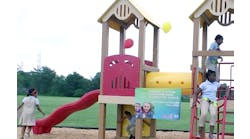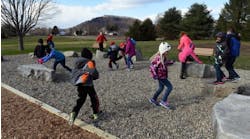For student learners to achieve complete development, it’s essential they have access to facilities that support exercise –physical activity and skill development. The next several columns will focus on designing educational facilities that exercise both the brain and the body.
We typically think of exercise in terms of cardio fitness, free weights and sports. We exercise to build muscle and stamina, to maintain or improve our body’s vital indicators (blood pressure, cholesterol, glucose level, etc.), and to remain healthy (preventing obesity, diabetes, and other conditions). For young and old alike, physical exercise makes one feel stronger, healthier and more mentally alert. As a result of these benefits, we expect to live longer, remain healthier as we age, enjoy our families, and make a long-lasting impact on our society.
Other forms of exercise engage the body mass between our ears: reading, writing, analyzing, performing mathematical functions, speaking, and listening. These skills help us learn new concepts and strategies, new ways of accomplishing objectives, and new approaches to becoming better human beings.
Linking these two forms of exercise together, studies recently published in Neurology, the medical journal of the American Academy of Neurology (AAN), indicate the brain exercises when we perform physical exercise. According to the AAN, through physical exercise, the brain increases production of neurochemicals that promote brain cell repair. Physical exercise improves memory, lengthens attention span, boosts decision-making skills, prompts growth of new nerve cells and blood vessels, and improves one’s ability to multitask and plan. Attention, perception, and motivation are improved. Brain cells grow and regulate mood, providing improved mental clarity. The part of the brain involved with learning and memory also grows in size thanks to physical exercise. Blood flow to the brain increases, delivering oxygen and nutrients and improving waste removal; dopamine is also released, improving motivation, focus, and learning. With such an abundance of benefits, we should strive to provide this for all learners!
From earliest days, as a child develops, physical exercise and extra-curricular activities stimulate the brain. Studies show that physical exercise helps children become more disciplined, focused and organized. How many times have we seen an excellent student who also excels in sports, performing arts, visual arts, debate or other extracurricular activities?
Every child has unique interests. A variety of physical activity choices need to be provided so that children can find their niche, rather than being herded with all students through the same short-term routine activities. According to the National Association for Sport and Physical Education (NASP), the trend is for physical education to be taught in different curriculum models: movement, sports, and fitness education. This teaches students the science behind fitness and the benefits of having a healthy lifestyle.
Along with this direction, appropriate facilities and proper equipment are needed to support these models of physical activity, including strength fitness, floor activities, indoor and outdoor court play, etc.
Likewise, the educational community understands that each child’s mind is unique, and that learning is different for each child. Thus, curriculum is trending toward flexibility in delivery models to accommodate this diversity. Learning encompasses different multiple intelligences (such as described by Howard Gardner, Hobbs Professor of Cognition and Education at Harvard Graduate School of Education) including visual-spatial, interpersonal, intrapersonal, musical, naturalistic, logical, etc. Educational facilities need to be designed to accommodate these learning variables: different-sized spaces, flexible furniture, busy-to-quiet spaces, formal-to-informal spaces, etc.
Designing facilities to support physical and mental exercise helps our children develop into healthy adults who can strengthen society.


